Data Interpretation
Data Interpretation - Data Interpretation is topic related with quantitative aptitude section. To solve questions related to this section candidates should be efficient in calculation methodology and reading the data properly. In this topic data is represented using various kinds of tables, pie charts, bar graphs, line charts, etc. As per trending pattern of the examination, questions from Data Interpretation topic is appearing in the examination with missing values & arithmetic based.
Candidates who want to well versed with Data Interpretation topic should practice numerous problems of this topic to score well in exam.Nowadays Data Interpretation has become the most important chapter in all the exams. It is also a common topic in all the government job exams. It is not dependable over any mathematical topic, just the basic calculation is required to crack the problems related to this topic.

How to prepare data interpretation?
Before coming to this brush up your calculation skills along with all the arithmetic chapters.
Be comfortable in understanding the different different types of charts and graphs.
Learn to eliminate superfluous calculation.
Learn the observation tricks to solve some specific kind of questions.
Practice from books and past papers
Practice from various online test series to be comfortable with new pattern problems
Practice questions of Data Interpretation
Q 1. Directions for Q1 to Q5: The question is based on the pie chart given below. Constituents of Sun Rays received in 1 minute.
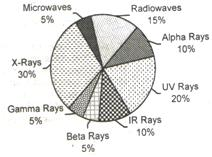
Total sunrays received in 1 minute = 3600 units
If the human body can withstand a maximum of 9720 units of IR rays when exposed to the sun continuously, then what is the maximum time (in minutes) that any person could stand in the sun without crossing the threshold limit of IR rays?
25
23
27
29
19
Q 2. The amount of Beta rays in 10 minutes of sun rays is how many times the amount of IR rays in 3 minutes of sun rays?
1.33
1.44
1.66
1.45
1.55
Q 3. How many minutes of exposure to the sun in a day would be enough to ensure that the body receives enough amount of Vitamin D, given that the body requires 40 units of Vitamin D every day and that 30 units of Beta rays generate in 1 unit of Vitamin D?
23/3
16/3
17/3
20/3
19/3
Q 4. The amount of Alpha rays received in 2 minutes is how many more/less than the amount of radio saves received in 4 minutes?
1540 units more
1320 units more
1440 units less
1600 units more
1200 units less
Q 5. If presently the ozone layer in the atmosphere reflects away 60% of the sun's rays then what would the amount of gamma rays received in one minute, if the ozone layer were to completely disappear?
250 units
200 units
300 units
450 units
100 units
Q 6. Directions for Q6 to Q10: The question is based on the line graph below.
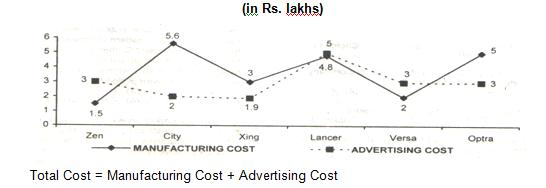
For which of the following cars is the manufacturing cost as a percentage of advertising cost the least?
Xing
least
Lancer
Zen
City
Q 7. In a certain year, 30, 000 "City" cars, are produced, and are sold at Rs. 9.3 lacs/car. If 2% of the total profit is given as a bonus to the 2,040 engineers, the amount received by each engineer as bonus is (in Rs.)
5, 000
50, 000
5 lacs
42, 000
None of these
Q 8. Which of the following statements is true?
The total cost of Zen and Xing put together is less than the cost of Lancer.
The ratio of the manufacturing to the advertising cost of Zen is the same as that of Xing.
The total cost of Zen and Xing put together is less than the total cost of Lancer.
None of these
The difference in the manufacturing and advertising costs of Optra is the same as that of Versa.
Q 9. The company that manufactures Zen produces 500 Zen cars per day while the company that manufactures City produces 600 City per day. They sell them at Rs. 6 lacs/car and Rs. 8.4 lacs/car respectively. The profit made by the former is approximately what percentage of that of the latter?
100%
156%
42 %
None of these
250%
Q 10. The ratio of the manufacturing cost to the total cost is the least for
Optra
Zen
City
ratio
Lancer
Q 11. Directions for Q11 to Q15: These questions are based on the line graph given below which represents the Earnings Per Share (EPS) of three companies STC, TSC and MIE for the years 1991-1992 to 1995-1996.
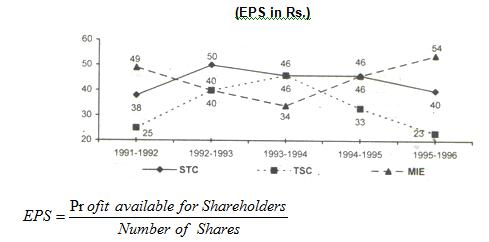
If TSC has 15, 000 shares in 1994-1995 and 31, 000 shares in 1995-1996, then find the approximate percentage change in profit available for shareholders from 1994-1995 to 1995-1996.
35%
59.6%
44.1%
 %
%61%
Q 12. If the number of shares of TSC in 1993-1994 is the same as in 1994-1995, then which of the following is true.
Ratio of EPS for both these years is the same as that of the profit available from shareholders.
Profit available for shareholders for these five years is the same.
Ratio of EPS for these two years in half that of the profit available for the shareholders.
Both (1) and (2)
Profit available for shareholders for these two years is the same.
Q 13. If TSC, STC and MIE have 10, 000, 25, 000 and 15, 000 shares respectively in 1991-1992, then which company has the maximum profit available for shareholders in that year?
TSC
STC
MIE
MTC and STC
STC and TSC
Q 14. If TSC and STC have Rs. 6 lacs each as profit available for shareholders in 92-93, then the ratio of the number of shares of STC and TSC is

4 : 5
5 : 4
20 : 12
1 : 1
Q 15. If STC has to pay 10% of the profit available for share-holders as tax in the year 1993-1994, then the tax payable for 12,000 shares is
Rs. 62, 200
Rs. 55, 200
Rs. 60, 000
Rs. 57, 200
Rs. 50, 000
Q 16. Directions for Q16 to Q19 : The following question is based on the stacked bar graph given below.
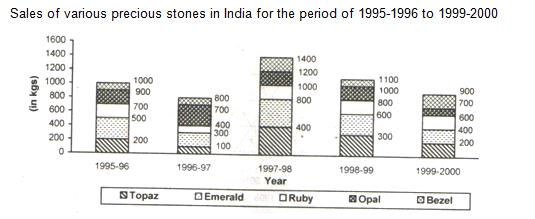
What is the total sales of ruby as a percent of the total sales of precious stones for the given period?
17.3%
19.23%
23.1%
25 %
None of these
Q 17. By what percent is the average annual sales of Emerald for the given period more than the sales of Opal in 1998-1999?
120%
75 %
25%
40%
50%
Q 18. For how many years is the sales of Bezel as a percentage of the total sales of precious stones less than that of Topaz?
five
Two
Three
Four
One
Q 19. If the sales of Topaz increased from 1994-1995 to 1995-1996 by 25% and increased from 1999-2000 to 2000-01 by 50%, then what is the difference between the sales of Topaz in 1994-95 and that in 2000-01?.
50, 000 tonnes
150, 000 tonnes
140, 000 tonnes
160, 000 tonnes
100, 000 tonnes
Q 20. Direction for Q20 to Q24: Study the following table and answer the questions based on it.
Expenditures of a Company (in Lakh Rupees) per Annum Over the given Years
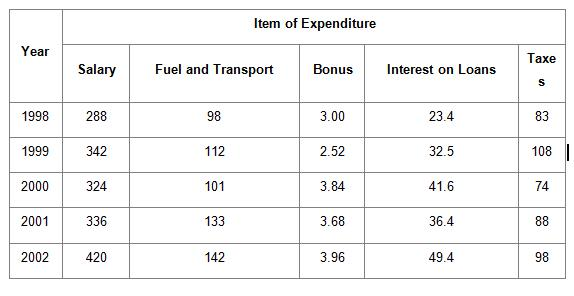
What is the average amount of interest per year which the company had to pay during this period?
Rs. 32.43 lakhs
Rs. 33.72 lakhs
Rs 35 lakhs
Rs. 36.66 lakhs
Rs. 34.18 lakhs
Q 21. The total amount of bonus paid by the company during the given period is approximately what percent of the total amount of salary paid during this period?
0.1%
1.5 %
1%
1.25%
0.5%
Q 22. Total expenditure on all these items in 1998 was approximately what percent of the total expenditure in 2002?
79%
66%
69%
71%
62%
Q 23. The total expenditure of the company over these items during the year 2000 is?
Rs. 544.44 lakhs
Rs. 501.11 lakhs
Rs. 446.46 lakhs
Rs. 534.32 lakhs
Rs. 478.87 lakhs
Q 24. The ratio between the total expenditure on Taxes for all the years and the total expenditure on Fuel and Transport for all the years respectively is approximately?
14:12
10:13
15:18
5:8
4:7
Q 25. Direction for Q25: Number of Candidates Appeared and Qualified in a Competitive Examination from the Different States Over the Years.
State | Year | |||||||||
1997 | 1998 | 1999 | 2000 | 2001 | ||||||
App. | Qual. | App. | Qual. | App. | Qual. | App. | Qual. | App. | Qual. | |
M | 5200 | 720 | 8500 | 980 | 7400 | 850 | 6800 | 775 | 9500 | 1125 |
N | 7500 | 840 | 9200 | 1050 | 8450 | 920 | 9200 | 980 | 8800 | 1020 |
P | 6400 | 780 | 8800 | 1020 | 7800 | 890 | 8750 | 1010 | 9750 | 1250 |
Q | 8100 | 950 | 9500 | 1240 | 8700 | 980 | 9700 | 1200 | 8950 | 995 |
R | 7800 | 870 | 7600 | 940 | 9800 | 1350 | 7600 | 945 | 7990 | 885 |
Total number of candidates qualified from all the states together in 1997 is approximately what percentage of the total number of candidates qualified from all the states together in 1998?
72%
77%
80%
65 %
83%
Applications for Admissions are open.
Apply for Online M.Com from Manipal University
